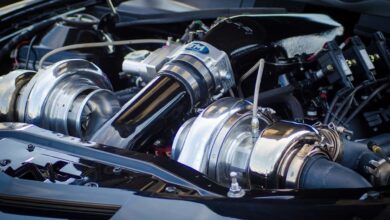Unleashing Power: Twin Turbo vs Single Turbo vs Naturally Aspirated

Turbocharging has revolutionized the automotive industry, offering a significant boost in performance by forcing more air into the engine, resulting in increased power output. Among the various turbocharging configurations, the debate often centers around twin turbo vs single turbo and turbo vs naturally aspirated setups. Each configuration has its unique advantages and considerations, catering to different preferences and driving experiences.
Twin Turbo vs Single Turbo
The twin turbo and single turbo configurations represent distinct approaches to turbocharging. Twin turbo systems utilize two smaller turbos, typically operating in parallel, to deliver improved throttle response and efficiency across the RPM range. Single turbo setups, on the other hand, feature a larger turbocharger that may take slightly longer to spool but can deliver a more concentrated boost at higher RPMs.
Twin turbo setups are favored for their ability to provide a seamless power delivery, minimizing turbo lag and ensuring a consistent flow of power. This configuration often divides the workload between the two turbos, optimizing performance across the entire power band. In contrast, a single turbo may exhibit more noticeable lag at lower RPMs but can unleash a powerful surge at higher engine speeds.
Drivers seeking a balance between low-end torque and high-end power may find the twin turbo configuration appealing. The two turbos complement each other, resulting in a smoother power curve and enhanced drivability. On the other hand, enthusiasts chasing top-end power and performance may lean towards the simplicity and brute force of a single turbo setup.
Turbo vs Naturally Aspirated
Comparing turbocharged engines to naturally aspirated engines adds another layer to the discussion. Naturally aspirated engines rely solely on atmospheric pressure to deliver air to the combustion chamber. While they offer a linear power delivery and are often praised for their responsiveness, they may lack the raw power potential of turbocharged counterparts.
Turbocharged engines, whether equipped with a single or twin turbo setup, have the advantage of forced induction, allowing them to pack more air and fuel into the combustion chamber. This results in higher power outputs, especially at higher RPMs. However, the trade-off may include increased complexity, potential turbo lag, and additional stress on engine components.
Choosing between turbo and naturally aspirated configurations often boils down to individual preferences and driving priorities. Purists who appreciate a raw and immediate connection with the throttle may favor naturally aspirated engines. In contrast, those who crave the thrill of acceleration and top-end power may find the turbocharged experience more exhilarating. Because turbo is a boost to machine which operate as adding booster that need to accelerate faster than naturally aspirated machine.
In the ongoing debate of twin turbo vs single turbo and turbo vs naturally aspirated, there is no one-size-fits-all answer. Each configuration has its merits and trade-offs, catering to different driving preferences and performance priorities. Whether you prioritize seamless power delivery, top-end performance, or the simplicity of a naturally aspirated engine, the turbocharging landscape offers a diverse array of options for automotive enthusiasts to explore and enjoy. You can now know which way is better for your automotive. Also, you can see Procharger vs Turbo vs Supercharger.





